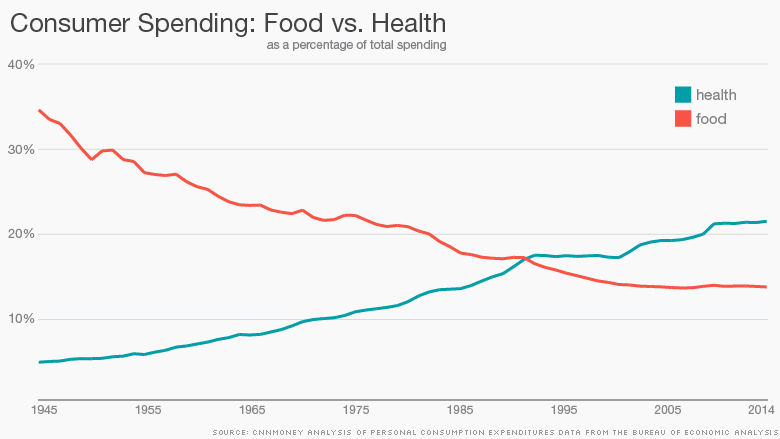
There's a lot you don't know about what you're eating.
Here are some of the most important things we learned while reporting CNNMoney's Raw Ingredients series.
1. The food industry is vast
The U.S. spends a lot of money on food. We're talking $1.5 trillion a year, according to the Bureau of Economic Analysis. That's trillion with a T.
That means everything about our food system is huge. Cornfields for miles. Facilities that process a million pounds of salad in a day. Frozen warehouses that store 15,000 tons of food.
2. Corn is the foundation
The U.S. produced almost 800 billion pounds of corn in 2014.
It's the basis of much of our food: It goes into animal feed, high-fructose corn syrup, cereal, starch and some alcohol. So if you're eating meat and cereal or drinking soda, there's a good chance it all started with corn.
And the government subsidizes corn production heavily. More than $84 billion of taxpayer money has been spent since 1995 on corn subsidies, according to an Environmental Working Group analysis of USDA data.
3. The industry has a fat wallet and lots of influence
When it comes to new regulations, food companies and their lobbying groups will throw their weight around.
Beginning in 2001, the USDA's Microbiological Data Program shouldered about 80% of all public testing for pathogens in produce and regularly called for recalls. The produce industry lobbied against it, claiming that the agency within the USDA that ran it didn't have the authority to test produce.
When the FDA moved to prohibit the use of poultry litter (that is, chicken poop) in cattle feed to prevent Mad Cow Disease in 2004, the industry argued that science didn't justify the ban. Four years later, the FDA decided the regulation wasn't necessary, saying it addressed the issue in other ways.

4. Critics say there should be more food testing
Mansour Samadpour runs IEH Laboratories, one of the largest private food testing facilities in the nation. Companies hire him to test their food and make sure it's safe for the consumer.
He believes much of the current testing is too infrequent and small in scale. "We call that faith-based food safety," he says.
Why do companies resist more testing? If more was done at the retail level, it would "always result in recalls," Samadpour says, because they find pathogens in the food so often.
But he also insists that some companies "are doing everything that they can" with regard to food safety.
And in a historic move, the FDA recently launched a program that actively monitors high-risk produce.
5. The environment is not the main priority
The aim of the food industry is having food at our fingertips -- available anytime, anywhere. But we use a lot of resources to make that happen.
One example: California is facing a historic drought, but it's still very green in the Salinas Valley, called the Salad Bowl of America. Agriculture in the state uses 40% of the water supply, according to the Public Policy Institute of California. The industry argues that much of the water they use seeps back into the aquifer.
But because of all the farming, that ground water has been tainted by fertilizer. One small town in the area had unsafe drinking water for three years because of high nitrate levels, not uncommon in areas with lots of agriculture.
Another example: Consuming 4 oz. of beef or lamb releases the same amount of greenhouse gas as driving more than 6 miles.
6. Neither is your health
Americans are spending less money on food than ever before, but they are spending more on health care (as a percentage of overall spending).

There are a lot of reasons why, but many experts tie it to the quality of the food we eat. The Oxfam Food Index ranks the U.S. high when it comes to food availability and affordability, but it's one of the worst in the world when it comes to diseases like diabetes and obesity.
On top of that, more than 70% of all antibiotics sold in the U.S. are for use in animal feed. Public health experts have been ringing the alarm bell for years, saying humans could get sick as a result.
Antibiotic use in animal feed, "raises concerns regarding how effective those drugs could be later in human medicine," according to Keeve Nachman at Johns Hopkins' Center for a Livable Future.
7. Companies adapt to consumer demands
Food companies really want to give consumers what they want. Fewer artificial ingredients, meatier fish, prewashed salads ... producers are constantly evolving their products in response to customer feedback.
"The strategy is consumer first," said Ken Powell, CEO of General Mills (GIS), which is lowering sugar and taking artificial colors out of all of its cereals. "The consumer is changing ... I've been in this business a long time and it's changing faster than I've ever seen."
If Americans want healthier, more wholesome food, they simply need to ask for it.
"If consumers become more active and they are demanding more ... those changes will happen very fast," said Samadpour, the food tester. If consumers don't care, companies will choose the most efficient methods, he says.


